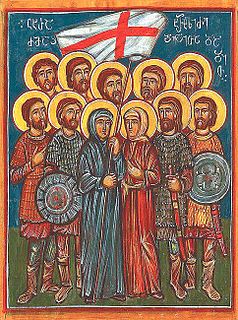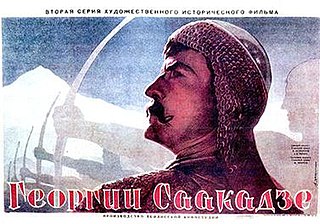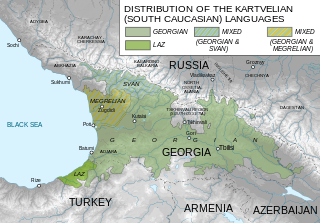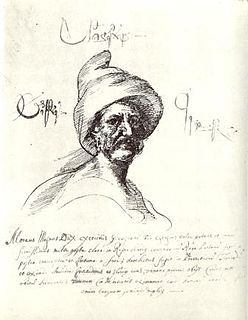This page is based on this
Wikipedia article Text is available under the
CC BY-SA 4.0 license; additional terms may apply.
Images, videos and audio are available under their respective licenses.
The Battle of Martqopi was a 1625 military confrontation between the Georgian Kingdom of Kartli and Safavid Iran. The Georgians, led by general Giorgi Saakadze, annihilated an Iranian detachment of Shah-Abbas I.

The Battle of Marabda took place on 30 June 1625, or July 1, 1625, when the Iranian Safavid army defeated a Georgian force. This battle occurred after the Battle of Martqopi in the same year, when the Iranian army was routed.

Luarsab II the Holy Martyr, of the Bagrationi dynasty, was a king of Kartli from 1606 to 1615. He is known for his martyr’s death at the hands of the Persian shah Abbas I. The Georgian Orthodox Church regards him as saint and marks his memory on the day of his death, July 1.

George III, of the Bagrationi Dynasty, was a king of Imereti from 1605 to 1639.
Mouravi was an administrative and military officer in early modern Georgia, translated into English as seneschal, bailiff, or constable. A mouravi was an appointed royal official who had a jurisdiction over particular town or district. In towns, the mouravi was assisted by a police officer, natsvali. The best-known mouravi in Georgian history was Giorgi Saakadze, called "the Grand Mouravi."
The Battle of Bazaleti was fought between the two rival Georgian parties centered respectively on Teimuraz I of Kakheti and his defiant noble Giorgi Saakadze in the fall of 1626.

Nine Brothers Kherkheulidze with their mother and sister were heroes of the Battle of Marabda. All of them died defending their motherland.
Rostam Khan or Rostom-Khan Saakadze was a high-ranking Safavid military commander and official of Georgian origin. He held the position of commander-in-chief (sepahsalar) under the Safavid shahs, Abbas I and Safi. In 1643, he was accused of treason and executed under king Abbas II. He features in the contemporary Persian and Georgian chronicles and is also a subject of the 17th-century Persian biography written by a certain Bijan for Rostam Khan's grandson, his namesake and a high-ranking officer in Iran.
Teimuraz I was a Georgian tavadi ("prince") of the House of Mukhrani, a collateral branch of the royal Bagrationi dynasty of Kartli, and Prince (Mukhranbatoni) of Mukhrani from 1580 until his death. At the same time, he was an ex officio commander of the Banner of Shida Kartli and regent of Kartli, from 1623 to 1625, during the rebellion against Safavid Iran. Teimuraz was killed at the battle of Marabda against the Iranian punitive army.
Kaikhosro was a Georgian tavadi ("prince") of the House of Mukhrani, a collateral branch of the royal Bagrationi dynasty of Kartli. He was Prince (Mukhranbatoni) of Mukhrani, ex officio commander of the Banner of Shida Kartli, and regent of Kartli from 1625 to 1626. During the civil war in 1626, Kaikhosro sided with Giorgi Saakadze against Teimuraz I of Kakheti and followed him into exile in the Ottoman Empire, where they both, after three years of military service, were accused of treason and put to death.
Zurab Araghvis Eristavi, also known as Sohrab Araghvis Eristavi, was a Georgian duke (eristavi) of the Duchy of Aragvi (1619—1629), who initially served the Safavids, and played a leading role in Georgian politics in the first decades of the 17th century. Later, he joined Giorgi Saakadze's anti-Persian uprising in 1625—26, switched sides to join Teimuraz I of Kakheti against Saakadze, but was eventually murdered by his new ally.
Safiqoli Beg, later known as Safiqoli Khan, was a Safavid official and gholam of Georgian origin, who served as the governor (beglarbeg) of Mashhad from 1664 to 1666, and of the Erivan Province from 1674 to 1679.
Kaykhosrow Khan was a Safavid military commander and gholam of Georgian descent. He served as the commander of the musketeer corps (tofangchi-aghasi) from 1670 to 1674, during the reign of king Suleiman I.
Aliqoli Khan was a Safavid official, gholam, and high-ranking military commander of Georgian origin, who served during the reign of three consecutive Safavid kings (shahs); Safi, Abbas II and Suleiman I

Giorgi Saakadze is a 1942 Soviet drama film directed by Mikheil Chiaureli.
Rostam Khan was a Safavid military commander, gholam, and official from the Georgian Saakadze family. He served as commander-in-chief, commander of the musketeer corps (tofangchi-aghasi), chancellor/chief justice (divanbegi), and governor (beglarbeg) of the Azerbaijan Province under king (shah) Suleiman I.







